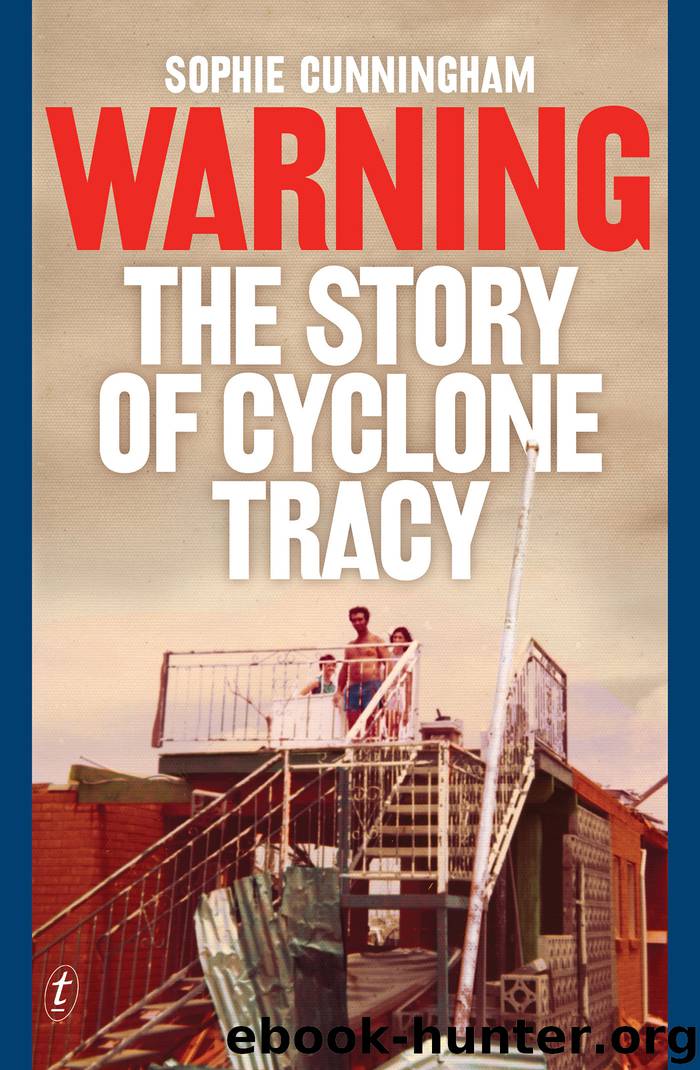Warning by Sophie Cunningham

Author:Sophie Cunningham
Language: eng
Format: epub
Publisher: The Text Publishing Company
Published: 2014-07-23T04:00:00+00:00
Many remote Indigenous communities in Australia are in areas at most risk of a ‘natural’ disaster but the Northern Territory—in fact Australia in general—is a long way away from having developed protocols around the evacuation of Aboriginal people. This is difficult, it must be acknowledged, because every Indigenous community is different, and a ‘one size fits all’ approach would not be much use. What is essential is having emergency services personnel who, if they are not actually from the community, know and work closely with them. A case in point was the evacuation undertaken before Cyclone Monica, a Category 5, hit the northern tip of Arnhem Land in 2005. Elders were invited to play an active role and, importantly, avoidance relationships were respected. These relationships are particularly important because they dictate who can be in close proximity to whom. If these aren’t understood and worked around, people might simply refuse to get onto the transport being offered. In this case the liaison officers were Indigenous, which made a huge difference to the emergency evacuation work.11
On the other hand there are many examples of evacuations that have caused extreme stress. The Western Desert community of Kiwirrkurra, badly flooded in March 2001, was a dry community but was evacuated to a community where drinking was allowed. There was such ‘severe disruption to the social fabric of the community’12 that they decided to move themselves closer to home and just stayed wherever they could. It was eighteen months before they were able to return to their land.
Evacuation was also distressingly disruptive to the people of the Warmun community in Turkey Creek, home to the art movement that had been triggered by artistic response to Cyclone Tracy—particularly the Gurirr Gurirr paintings—and Rover Thomas’s extraordinary oeuvre, which includes some of the most iconic visual images of the cyclone. (No other artists have painted the recent history of northern Australia in such an ambitious, or, indeed, historically significant fashion. Thomas’s painting in the late seventies inspired those around him, including Queenie McKenzie, a Gija elder and stock-camp cook who is now as famous as Thomas. ‘If he can do that so can I,’ she said.13 And so an art movement was born.)
In July 2010, it rained sixty-seven millimetres in a single day at Fitzroy Crossing, and, locals told me, closer to a hundred millimetres in other areas of Central Kimberley. It typically doesn’t rain a drop in July. Six months later the people of Warmun began to dream that something was amiss. On Sunday 13 March 2011, after days of heavy rainfall caused by a cyclonic depression, floodwaters began swelling Turkey Creek. In the space of a few short hours that afternoon, the creek rose beyond measure and a torrent of water sweeping across the red plains engulfed the remote community, washing away walls and taking a thousand paintings. Nicolas Rothwell reported in the Australian: ‘It was devastation: houses were wrecked, trailers and demountables were smashed and turned upside down, refrigerators lodged high in the branches of trees.
Download
This site does not store any files on its server. We only index and link to content provided by other sites. Please contact the content providers to delete copyright contents if any and email us, we'll remove relevant links or contents immediately.
Man-made Catastrophes and Risk Information Concealment by Dmitry Chernov & Didier Sornette(5946)
The Revenge of Geography: What the Map Tells Us About Coming Conflicts and the Battle Against Fate by Kaplan Robert D(4050)
Zero Waste Home by Bea Johnson(3802)
COSMOS by Carl Sagan(3581)
Good by S. Walden(3513)
In a Sunburned Country by Bill Bryson(3501)
The Fate of Rome: Climate, Disease, and the End of an Empire (The Princeton History of the Ancient World) by Kyle Harper(3029)
A Wilder Time by William E. Glassley(2832)
Camino Island by John Grisham(2775)
Organic Mushroom Farming and Mycoremediation by Tradd Cotter(2657)
The Ogre by Doug Scott(2652)
Human Dynamics Research in Smart and Connected Communities by Shih-Lung Shaw & Daniel Sui(2477)
Energy Myths and Realities by Vaclav Smil(2456)
The Traveler's Gift by Andy Andrews(2431)
9781803241661-PYTHON FOR ARCGIS PRO by Unknown(2338)
Inside the Middle East by Avi Melamed(2320)
Birds of New Guinea by Pratt Thane K.; Beehler Bruce M.; Anderton John C(2233)
A History of Warfare by John Keegan(2205)
And the Band Played On by Randy Shilts(2159)
